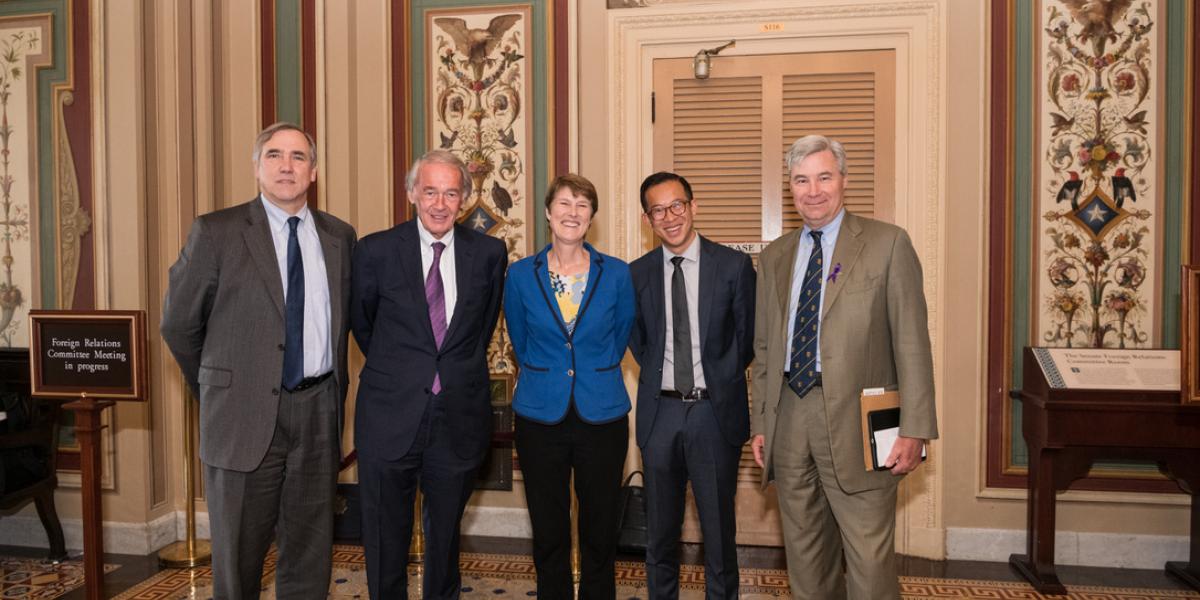
The following is Kyle Meng's written statement from his meeting with the US Senate Climate Task force in Washington, D.C. on June 25th, 2019.
Thank you Senators Markey, Whitehouse, and Schatz, and other members of the Senate Climate Change Task Force for inviting me to speak today.
My name is Kyle Meng and I am an assistant professor at the Bren School of Environmental Science and Management and the Department of Economics at the University of California, Santa Barbara. I am also co-director of the Climate & Energy program at UCSB's Environmental Markets Solutions Lab, an interdisciplinary team of economists and scientists that brings cutting-edge, data-driven research towards solving the world's most pressing environmental problems.
As an environmental economist, I have devoted my career to studying the social and economic consequences of climate change and the policies that address it.
Nearly ten years ago, on June 26, 2009, the U.S. House of Representatives passed the American Clean Energy and Security Act. Known also as the Waxman-Markey bill, this comprehensive U.S. climate policy would have placed a significant economy-wide price on greenhouse gas emissions. It was and remains the most prominent and promising U.S. climate legislation considered to date.
Unfortunately, as many of you know too well, Waxman-Markey did not garner enough support in the Senate, and thus never became law.
I have spent much of the last ten years studying this historic bill. This includes conducting the only data-driven analysis of the economy-wide cost of the Waxman-Markey bill, published in the American Economic Review. I have also quantified how political lobbying affected Waxman-Markey's chances of being implemented, which published last month in Nature Climate Change.
I would like to take this opportunity to summarize two lessons learned from this research, in particular as it informs the growing climate policy discussions that are once again sweeping through Congress.
I. The Economics of Climate Policy
In the last ten years, we have learned a tremendous amount about the costs and benefits of climate policy. An explosion of recent research now shows that climate policy can deliver significantly larger benefits to human health, economic growth, and social stability than we understood back in 2009.
At the same time, research has also shown that achieving substantial emissions reduction is less costly than previously thought. In my empirical analysis of the Waxman-Markey bill, I find that Waxman-Markey would have cost half of what leading economic models projected at the time.
This is before the recent unprecedented technological changes that have dramatically brought down the costs of renewable energy and natural gas prices. While my research has shown that such technological breakthroughs are not enough to sustain a permanent U.S. clean energy transition, they do provide substantial tailwind in lowering the cost of U.S. climate policy.
In short, higher climate policy benefits, lower policy costs, together with the tailwinds from falling clean energy prices all suggest that there is a stronger economic case for an ambitious climate policy in 2019 than there was in 2009.
II. The Politics of Climate Policy
However, despite the stronger economic rationale for U.S. climate policy, one must still contend with the political feasibility of enacting it. Climate change is a long-term problem and needs sustained long-term policy. Enduring policies are only possible with broad popular support. I believe it is fair to say that given the narrow margin under which Waxman-Markey passed the House, that such broad support was not there in 2009.
The next U.S. climate bill can be different. To start, one can take a page right out of the Waxman-Markey bill, whose centerpiece cap-and-trade system, like any carbon pricing policy, generates substantial government revenue.
Had Waxman-Markey been implemented, that additional revenue would have been valued at around $90 billion today, about 10 times larger than EPA's annual budget.
The prevailing view in 2009 was that this revenue should be distributed to energy-intensive and trade-exposed companies to offset their regulatory costs under climate policy. However, as my recent paper with Ashwin Rode at the University of Chicago shows, political lobbying by these and other companies still managed to lowered the chances of passing the bill despite this compensation, resulting in a social cost of $60 billion from higher expected climate damages. That is, the compensation strategy behind Waxman-Markey did not build sufficient political support for the policy.
What if, instead, the next U.S. climate policy took a different approach to building political support. Rather than offset losses by companies, it can focus on providing direct benefits to American households through addressing other pressing priorities of our time. For example, this revenue can help lower health care costs for millions of Americans; it can be spent to increase educational opportunities for those who are historically underserved; or, it can be recycled directly as income in a progressive manner back to households.
If the revenue is to stay within the climate realm, one could use it to help communities across American become more resilient to the impacts of climate change which are already occurring in the form of higher temperatures, more frequent droughts and floods, and less unpredictable hurricane patterns.
More generally, across these different spending options, there lies a fundamental opportunity to connect climate policy with the other headline social issue of our time: increasing economic inequality.
Policies succeed and endure when they create clear, salient benefits to voters. Carbon pricing policies provides an opportunity to generate such benefits and thus political support from the revenues it collects.
We have a clear example of this in my home state of California. Every year, Californian households receive a check out of the auction revenue of the state's cap-and-trade policy. This regular, tangible, benefit linked to California's climate policy serves as a powerful reminder of what the state is doing to address climate change while also directly benefiting Californian households. The potential for such an approach would be much bigger at the national level.
Conclusion
The U.S. was on the brink of implementing climate policy ten years ago. That promise is reignited today. Since Waxman-Markey, we have learned that the benefits of climate policy are far larger than we thought, while costs are lower. This sets the stage for a more ambitious, new generation of U.S. climate bills.
However, as the recent IPCC report reminds us, time is running out and there is little, if any, room now for more failed policies. To ensure success this time around, the next U.S. climate effort must not only take advantage of the economic tailwinds before us but must also learn from the past in building a more politically robust climate policy.
Thank you for your attention and I look forward to our discussions.



